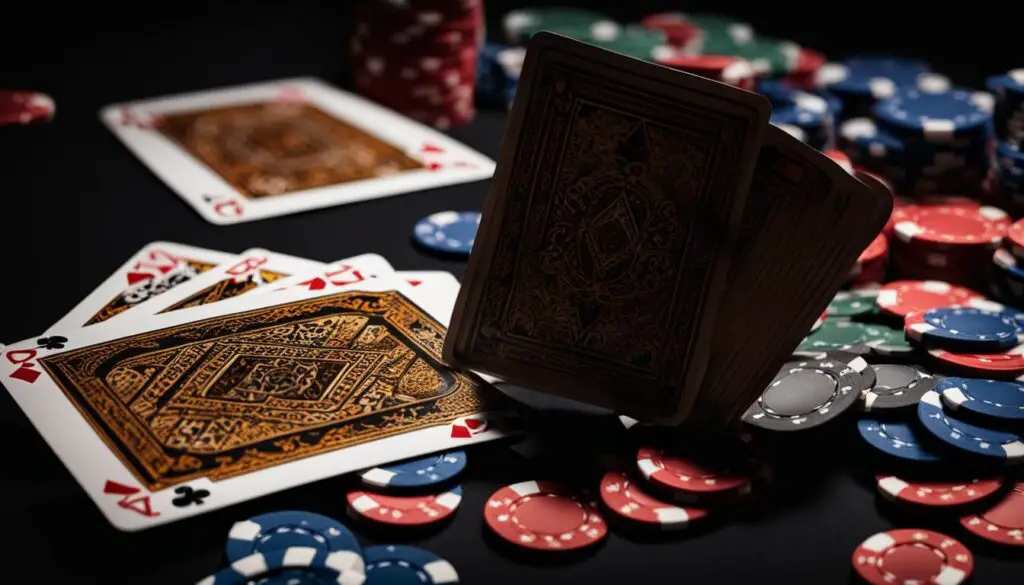Burning a card in poker may seem like a peculiar practice, but it serves a vital purpose in maintaining fair gameplay and preserving the integrity of the game. In this comprehensive guide, we will explore the significance of burning a card in poker, its strategic implications, the specific rules in Texas Hold’em, and its impact on gameplay and strategy.
Key Takeaways:
- Burning a card in poker is done to prevent cheating, specifically card marking.
- By discarding the top card before dealing, players are unable to anticipate the next card, ensuring fair gameplay.
- Burning a card adds an element of randomness, making it more challenging to predict the next card and enhancing the overall playing experience.
- In Texas Hold’em, the burn and turn rule is followed, where the dealer discards the top card before dealing the community cards.
- Burning a card ensures that the next cards dealt remain unknown to the players, leveling the playing field and adding an element of uncertainty to strategic decision-making.
Strategies Behind Burning a Card in Poker
Burning a card in poker is strategically important for several reasons:
- Preventing Cheating: Burning the top card of the deck before dealing helps to eliminate the possibility of card marking and ensures fair gameplay. It removes any potential advantage that players may gain from knowing the next card.
- Adding Randomness: By discarding a card, the element of surprise and uncertainty is introduced into the game. This makes it more challenging for players to predict the next card, creating excitement and enhancing the overall playing experience.
- Leveling the Playing Field: Burning a card helps to maintain the integrity of the game by equalizing the chances of all players. It eliminates any potential unfair advantages that may arise from card manipulation.
The concept of burning a card in poker is thus crucial in promoting fair play, increasing the excitement of the game, and ensuring that all players have an equal opportunity to succeed.
Key Takeaways:
- Burning a card prevents cheating and maintains the integrity of the game.
- It adds randomness and unpredictability, enhancing the playing experience.
- This practice levels the playing field, ensuring fair gameplay for all participants.
https://www.youtube.com/watch?v=_j93s2vVVhk
How Burning a Card Works in Texas Hold’em
In Texas Hold’em, one of the most popular poker variations, the burn and turn rule is followed. Before dealing the community cards (flop, turn, and river), the dealer is required to take the top card from the deck and discard it. This burn card remains face down and is never shown to the players. The purpose of burning the card is to prevent players from gaining any information about the upcoming cards, ensuring a fair gameplay. This rule is implemented in all Texas Hold’em games to maintain the integrity of the game.
In Texas Hold’em poker, the burn card is a crucial part of the game’s procedure. It serves as a safeguard against cheating and ensures that players have no advance knowledge of the upcoming community cards. By discarding a card before each round of community cards is dealt, the burn and turn rule creates an additional layer of unpredictability and excitement.
Implications of the Burn and Turn Rule
The burn and turn rule in Texas Hold’em has several implications for gameplay and strategy. Firstly, it eliminates the possibility of players gaining an unfair advantage by secretly marking cards or using information from previous rounds. By discarding the top card, any potential markings or knowledge are rendered irrelevant. This creates a level playing field for all players, enhancing the fairness of the game.
Secondly, the burn and turn rule adds an element of randomness and unpredictability to each round of community cards. Without knowing the identity of the burned card, players must rely on their skills, intuition, and the information available to them to make strategic decisions. This enhances the strategic depth of the game and requires players to adapt their strategies based on the constantly evolving information.
The burn and turn rule in Texas Hold’em prevents cheating and adds excitement and unpredictability to the game. By discarding a card before dealing the community cards, players cannot gain any advance knowledge or use marked cards to their advantage. This rule ensures fairness and integrity in Texas Hold’em poker and enhances the strategic aspects of the game.
The Role of Burn Cards in Cardroom Procedures
In poker, burn cards play a crucial role in maintaining the integrity of the game and ensuring fair gameplay. During each hand, the dealer is required to remove the top card from the undealt portion of the deck and place it face down on the table. This card, known as the burn card, is out of play and is never shown to the players. The purpose of this procedure is to prevent any potential cheating through card marking, ensuring a level playing field for all participants.
The use of burn cards is not limited to specific poker variations; it is a common practice in most games. By discarding the top card, players are unable to anticipate the next card to be dealt, thus eliminating any advantage gained through card marking. The presence of a burn card adds an element of randomness and unpredictability to the game, enhancing the excitement and strategic decision-making for players.

Implementing burn card procedures in poker is essential as it ensures that the next cards dealt from the deck remain unknown to the players. This prevents any potential manipulation or cheating and upholds the integrity of the game. By incorporating burn cards into cardroom procedures, poker establishments create a fair and transparent environment for all participants, emphasizing the importance of skill and strategic thinking over unfair advantages.
The Impact of Burning a Card on Gameplay and Strategy
Burning a card in poker has a profound impact on the overall gameplay and strategic decisions made by players. It serves as a key element in leveling the playing field and ensuring fair competition among all participants.
One of the primary effects of burning a card is the elimination of card marking, which can be used as a form of cheating. By discarding the top card of the deck before dealing, any potential markings become irrelevant, safeguarding the integrity of the game.
Furthermore, the presence of a burn card introduces an element of uncertainty and unpredictability. This aspect of the game makes it more challenging for players to rely solely on their card reading skills and forces them to adapt their strategies in response to the unknown.
Strategically, skilled players can capitalize on the presence of burn cards to gain a competitive edge. By carefully observing the cards that are burned, players can gather valuable information and make informed decisions about their subsequent moves. This strategic use of burn cards can be a game-changer and significantly impact the outcome of a poker game.
FAQ
Why do you burn a card in poker?
Burning a card in poker serves multiple purposes. The primary reason is to prevent cheating, specifically card marking. By discarding the top card of the deck before dealing, players are unable to anticipate the next card, ensuring fair gameplay. It also helps to maintain the integrity of the game by preventing players from gaining an unfair advantage.
What is the purpose of burning a card in poker?
Burning a card in poker is strategically important for several reasons. First, it reduces the chances of players using marked cards to gain an unfair advantage. By discarding the top card, any potential markings become irrelevant. Additionally, burning a card adds an element of randomness to the game, making it more challenging to predict the next card. This increases the excitement and suspense in poker games, enhancing the overall playing experience.
How does burning a card work in Texas Hold’em?
In Texas Hold’em, the burn and turn rule is followed. Before dealing the community cards (flop, turn, and river), the dealer is required to take the top card from the deck and discard it. This burn card remains face down and is never shown to the players. The purpose of burning the card is to prevent players from gaining any information about the upcoming cards, ensuring fair gameplay. This rule is implemented in all Texas Hold’em games to maintain the integrity of the game.
What is the role of burn cards in cardroom procedures?
The use of burn cards is not limited to Texas Hold’em; it is a common practice in most poker games. The dealer is required to remove the top card from the undealt portion of the deck, known as the burn card, and place it face down on the table. This card is out of play and is never shown to the players. The purpose of the burn card is to ensure that the next cards dealt from the deck remain unknown to the players. It adds an element of randomness and prevents any cheating through card marking.
What is the impact of burning a card on gameplay and strategy?
Burning a card has a significant impact on the gameplay and strategy in poker. It levels the playing field and ensures that all players have an equal chance of winning. By eliminating the possibility of card marking, it enhances the fairness and integrity of the game. Additionally, the presence of a burn card adds uncertainty and unpredictability, making it more challenging for players to make strategic decisions based on the upcoming cards. The strategic use of burn cards can influence the outcome of a poker game, making it an essential aspect of the game’s strategy.
